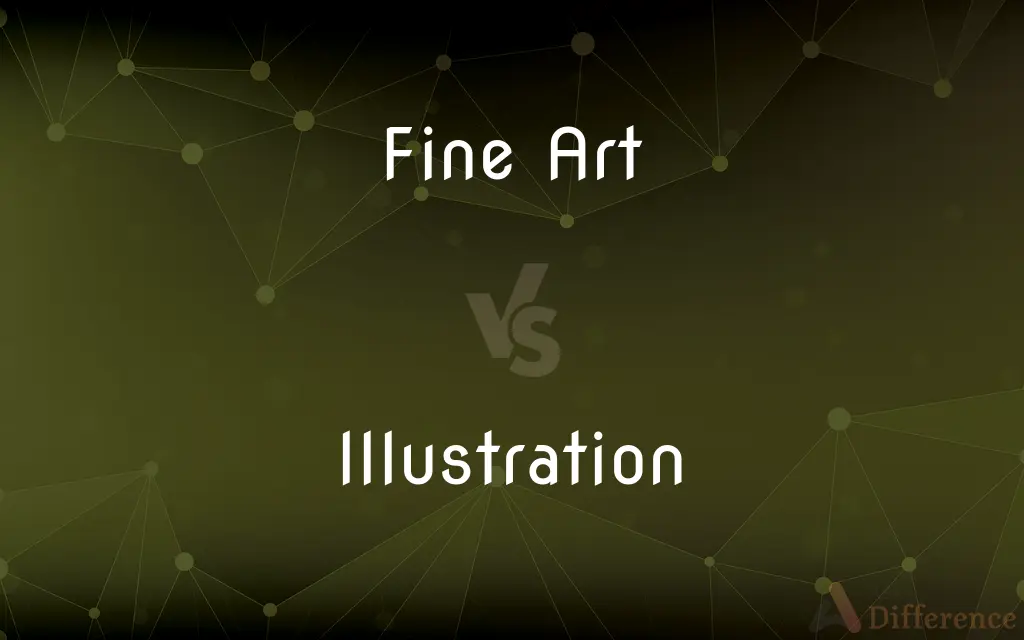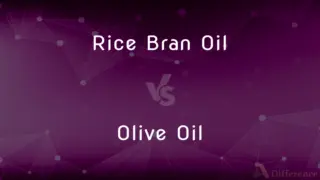Fine Art vs. Illustration — What's the Difference?
By Tayyaba Rehman — Published on November 18, 2023
Fine Art is created primarily for aesthetic expression, while Illustration is designed to convey a specific message or narrative visually.

Difference Between Fine Art and Illustration
Table of Contents
ADVERTISEMENT
Key Differences
Fine Art emphasizes personal, aesthetic expression and is often created for public or private appreciation without commercial intent. Contrarily, Illustration is fundamentally purpose-driven, created to illustrate, convey, or embellish a concept, typically in published media.
In the realm of Fine Art, artists explore their expressive freedoms without adherence to a client’s brief or specific practical function. Illustration, however, often involves a client or specific brief, tailoring the artwork to communicate effectively to a target audience.
While Fine Art might be showcased in galleries, museums, or personal collections, serving as an exploratory and expressive medium, Illustration is commonly found in books, magazines, and other media, serving to illuminate text, concepts, or narratives.
Fine Art prioritizes the artist’s intent and is subjective, inviting multiple interpretations from its audience. Illustration is typically direct and explicit in its message, intending to clearly convey specific information or assist textual content.
Fine Art seeks to engage viewers in a subjective, emotional, or intellectual experience, often transcending utilitarian communication. Illustration, while it can be aesthetically engaging, prioritizes clarity and effectiveness in relaying a particular message or assisting a story.
ADVERTISEMENT
Comparison Chart
Primary Purpose
Aesthetic and expressive
Communicative and functional
Commercial Intent
Often not intended for commercial use
Typically created for commercial or practical use
Place of Display/Publication
Galleries, museums, collections
Books, magazines, advertisements
Audience Interpretation
Open to varied interpretations
Aims for clear, specific communication
Dependence on External Brief
Generally independent of external instructions or briefs
Often created based on a specific brief
Compare with Definitions
Fine Art
Fine Art often involves traditional mediums like painting and sculpture.
This gallery showcases fine art from the Renaissance.
Illustration
Illustration aims to convey a clear, specific message or narrative.
The illustration accurately depicts the historical event.
Fine Art
Fine Art may have conceptual or theoretical underpinnings.
His work is rooted in fine art practices and theories.
Illustration
Illustration can be utilized in various media like books and advertisements.
Her illustration appeared in a popular children’s book.
Fine Art
Fine Art often explores personal or global themes through an artist’s lens.
Her fine art explores themes of identity and culture.
Illustration
Illustration visually represents or embellishes text or concepts.
The book features an illustration on every page.
Fine Art
Fine Art may not necessarily convey a clear, practical message.
Abstract fine art like this piece often invites varied interpretations.
Illustration
Illustration often involves creating images for publications.
He crafted an illustration for the magazine cover.
Fine Art
Fine Art is expressive and created for aesthetic enjoyment.
Her painting was a piece of fine art admired by many.
Illustration
Illustration may adhere to a client’s brief or specifications.
The illustrator adjusted the illustration according to client feedback.
Illustration
The act of illustrating or the state of being illustrated
Concepts that would benefit from illustration.
An idea that lends itself to illustration.
Illustration
A picture or image that is used to decorate or clarify a text.
Illustration
An example that is used to clarify or explain something.
Illustration
(Obsolete) Illumination.
Illustration
The act of illustrating; the act of making clear and distinct;
Illustration
The state of being illustrated, or of being made clear and distinct.
Illustration
Something which illustrates; a comparison or example intended to make clear or apprehensible, or to remove obscurity.
Illustration
A picture designed to decorate a publication, or elucidate a literary work.
The illustration showing the water cycle made it much easier to understand for the children.
The sleeve of the band's new CD includes illustrations from deceased former members.
Illustration
A calculated prevision of insurance premiums and returns (life insurance)
Illustration
The act of illustrating; the act of making clear and distinct; education; also, the state of being illustrated, or of being made clear and distinct.
Illustration
That which illustrates; a comparison or example intended to make clear or apprehensible, or to remove obscurity.
Illustration
A picture designed to decorate a volume or elucidate a literary work.
Illustration
Artwork that helps make something clear or attractive
Illustration
Showing by example
Illustration
An item of information that is representative of a type;
This patient provides a typical example of the syndrome
There is an example on page 10
Illustration
A visual representation (a picture or diagram) that is used make some subject more pleasing or easier to understand
Common Curiosities
Can a piece of Fine Art also be an Illustration and vice versa?
Yes, some works can function as both, depending on context and interpretation.
Does Fine Art always have to be created with traditional mediums?
No, Fine Art can utilize any medium as long as it emphasizes aesthetic and expressive qualities.
Is Illustration only found in children’s books?
No, Illustration is versatile and found in various media, including adult publications and commercial ads.
Is Digital Art commonly used in Illustration?
Yes, digital art is prevalent in Illustration due to its versatility and ease of revision and transmission.
Can Fine Art be bought and used for commercial purposes, like advertising?
Yes, though it wasn’t its original purpose, Fine Art can be utilized in commercial contexts.
Can Fine Art not have any message or meaning behind it?
It can; Fine Art may have a deep meaning, no apparent meaning, or be open to interpretation.
Is Fine Art always a single, unique piece, or can it be mass-produced?
While often unique, Fine Art can also involve printmaking, creating multiple authentic pieces.
Can an Illustration be created without a predefined concept or brief?
Yes, Illustrators may create work from personal inspiration without a predefined concept or brief.
Are all Illustrations commercially driven or made for clients?
No, while Illustration is often client-driven, personal or experimental illustrations also exist.
Is it necessary to study Fine Art to become an Illustrator?
No, while beneficial, many illustrators have varied educational backgrounds.
Does Illustration always need to support textual content?
No, Illustrations can stand alone or convey a message without accompanying text.
Can Fine Art be a collaborative work?
Yes, Fine Art can involve collaborations, challenging traditional notions of singular artistic authorship.
Can Fine Art incorporate textual elements?
Yes, Fine Art can include text as a visual or conceptual element.
Do all Illustrations need to be realistic or detailed?
No, Illustrations can be abstract, stylized, or simplistic, depending on the intended message.
Can Illustration be considered less valuable than Fine Art?
No, both have their own value and are appreciated for different reasons and contexts.
Share Your Discovery

Previous Comparison
Rice Bran Oil vs. Olive Oil
Next Comparison
Dachshund vs. Miniature DachshundAuthor Spotlight
Written by
Tayyaba RehmanTayyaba Rehman is a distinguished writer, currently serving as a primary contributor to askdifference.com. As a researcher in semantics and etymology, Tayyaba's passion for the complexity of languages and their distinctions has found a perfect home on the platform. Tayyaba delves into the intricacies of language, distinguishing between commonly confused words and phrases, thereby providing clarity for readers worldwide.
















































